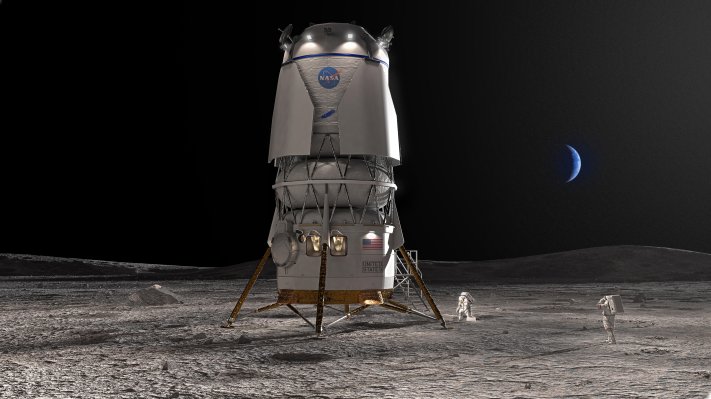NASA has chosen a Blue Origin-led team to develop a second lunar landing system for the Artemis program, as the agency looks to provide competition with SpaceX and support long-term exploration of the moon.
The winning team includes Lockheed Martin, Draper, Boeing, Astrobotic and Honeybee Robotics. The contract is valued at $3.4 billion, but Blue Origin Vice President John Couluris said the company plans to contribute “well north” of that number – meaning the entire endeavor will likely cost at least $7 billion. The team beat out one other proposal from Dynetics for this award, which is called Sustaining Lunar Development (SLD).
The SLD award includes an uncrewed demonstration landing and a crewed demonstration landing. NASA aims to use this vehicle and Starship to ferry astronauts between the lunar surface and an under-development space station it calls “Gateway” in order to enable a permanent human presence on the moon.
Under this award, the Blue Origin-led team will develop the landing system for the Artemis V mission, which is currently set to launch no earlier than September 2029. SpaceX’s two missions are scheduled for Artemis III and Artemis IV.
Blue Origin said it would develop a 52-foot tall lander its calling Blue Moon and land it on the lunar south pole. Blue Moon is sized to fit inside the payload failing of Blue’s under-development New Glenn rocket. The Blue-led team is planning on attempting an uncrewed mission a year before it will take astronauts. Another version of the lander is also being designed to take as much as 30 metric tons of cargo mass to the lunar surface.
According to Blue Origin officials at a Friday press conference, Lockheed Martin will build a “cislunar transporter” spacecraft for lander refueling; Draper will develop the guidance, navigation and control systems, as well as training and simulation; Astrobotic will work on cargo accommodations; Boeing will engineer the docking systems; and Honeybee Robots will be handling the cargo offloading capabilities.
NASA selected SpaceX to develop a Starship human landing system in April 2021 at a price of around $2.9 billion. It was notable at the time that the agency selected only one vendor for the task – so notable, in fact, that competitors Blue Origin and Dynetics filed protests with a major government watchdog over the decision. Those protests were dismissed. Blue Origin later filed a lawsuit against NASA in federal court over the decision, though the U.S. Court of Federal Claims ultimately ruled in the agency’s favor.
However, pressure on the agency to select a second vendor mounted from other sources — notable Congress — and last March NASA announced it would open competition for a second landing system. For that reason, SpaceX was not eligible to compete for this contract. However, it and this team will be eligible to compete for future crewed missions to the moon beyond Artemis V.
NASA’s Artemis program is incredibly ambitious. The agency wants to maintain a cadence of about a mission a month, with astronauts staying on the moon for up to thirty days at a time. NASA completed the first Artemis mission – Artemis I, which launched late last year – and is aiming to launch the follow-up Artemis II late 2024. For that mission, four astronauts will orbit the moon but not touch down on the surface. That honor is being saved for Artemis III, which is currently scheduled to launch in 2025.
“A second lander and additional, different lander will help ensure that we have the hardware necessary for a series of missions to carry out the science and technology development on the surface of the moon,” NASA Administrator Bill Nelson said.
Shortly after the news was announced, Bezos tweeted that he was “honored to be on this journey” with the space agency.
Honored to be on this journey with @NASA to land astronauts on the Moon — this time to stay. Together, we’ll be solving the boil-off problem and making LOX-LH2 a storable propellant combination, pushing forward the state of the art for all deep space missions. #Artemis… pic.twitter.com/Y0zDhnp1qX
— Jeff Bezos (@JeffBezos) May 19, 2023
